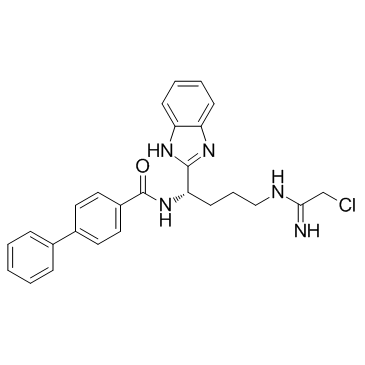| Description |
BB-Cl-Amidine is a peptidylarginine deminase (PAD) inhibitor.
|
| Related Catalog |
|
| Target |
PAD[1].
|
| In Vitro |
Cl-amidine and BB-Cl-amidine show similar in vitro potencies and selectivities; however, the cellular potency of BB-Cl-amidine is increased by more than 20-fold, evidenced by decreased EC50 values obtained from viability studies with U2OS osteosarcoma cells (8.8±0.6 μM vs >200 μM for Cl-amidine). Cl-amidine and BB-Cl-amidine significantly inhibit NET formation by MRL/lpr neutrophils[1].
|
| In Vivo |
Treatment with BB-Cl-amidine subtly reduces splenomegaly in MRL/lpr mice, while there is a trend towards increased circulating levels of anti-NET antibodies with PAD inhibitor treatment. However, neither PAD inhibitor affected body weight or total IgG levels. Indeed, treatment with both Cl-amidine and BB-Cl-amidine significantly improves endothelium-dependent vasorelaxation. The BB-Cl-amidine group also shows a strong trend towards downregulation of IRGs. Treatment with either Cl-amidine or BB-Cl-amidine significantly improves muzzle alopecia, in many cases preventing it entirely[1].
|
| Animal Admin |
Mice[1] MRL/lpr mice are treated with either Cl-amidine (Cl-am; 10 mg/kg/day) or BB-Cl-amidine (BB-Cl-am; 1 mg/kg/day) by daily subcutaneous injection from 8 to 14 weeks of age[1].
|
| References |
[1]. Knight JS, et al. Peptidylarginine deiminase inhibition disrupts NET formation and protects against kidney, skin and vascular disease in lupus-prone MRL/lpr mice. Ann Rheum Dis. 2015 Dec;74(12):2199-206.
|
